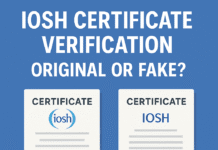
IOSH Managing Safely Exam Questions and Answers
The IOSH Managing Safely exam is a crucial step for individuals seeking to enhance their understanding of health and safety management in the workplace. This exam, designed by the Institution of Occupational Safety and Health (IOSH), evaluates candidates on various aspects of managing safety effectively within an organization. Whether you’re aiming to improve your career prospects or ensure a safer working environment, preparing for this exam is essential.
Preparation Tips for IOSH Managing Safely Exam
Before diving into the intricacies of the exam questions, it’s essential to prepare adequately. Understanding the exam format, familiarizing yourself with the study materials, and employing effective time management strategies can significantly improve your chances of success. The IOSH Managing Safely exam typically consists of multiple-choice questions and a risk assessment project. To excel in this exam, consider investing in reputable study resources such as textbooks, online courses, and practice exams. Additionally, create a study schedule that allows ample time for revision and practice.
Common Topics Covered in IOSH Managing Safely Exam
The IOSH Managing Safely exam covers a wide range of topics related to health and safety management. Some common areas include:
Risk Assessment
Candidates are often tested on their ability to identify workplace hazards, assess associated risks, and implement control measures to mitigate those risks effectively.
Incident Investigation
Understanding the process of incident investigation is crucial for maintaining a safe working environment. Questions in this category may focus on techniques for conducting thorough investigations and implementing corrective actions.
Hazard Identification
Identifying potential hazards in the workplace is fundamental to preventing accidents and injuries. Expect questions related to hazard recognition, evaluation, and control strategies.
Legal Requirements
Compliance with health and safety legislation is paramount for organizations. Candidates may encounter questions about relevant laws, regulations, and their implications for workplace safety.
Sample IOSH Managing Safely Exam Questions and Answers
To give you a better understanding of what to expect in the IOSH Managing Safely exam, here are some sample questions along with their answers:
Risk Assessment
- What is the first step in the risk assessment process?
- Answer: The first step is to identify hazards present in the workplace.
Incident Investigation
- What should be the immediate action following a workplace incident?
- Answer: The immediate action should be to ensure the safety of all individuals involved and secure the incident scene.
Hazard Identification
- Give an example of a physical hazard in the workplace.
- Answer: An example of a physical hazard is slippery floors due to spills or inadequate cleaning.
Legal Requirements
- What legislation outlines the employer’s duty to ensure the health and safety of employees?
- Answer: The Health and Safety at Work Act 1974 outlines the employer’s legal obligations regarding workplace safety.
Here are some sample questions and answers for the IOSH Managing Safely exam:What is the primary purpose of conducting a risk assessment in the workplace?
Answer: The primary purpose of conducting a risk assessment is to identify potential hazards and assess the associated risks to the health and safety of employees and others affected by the workplace activities. This allows for the implementation of appropriate control measures to mitigate or eliminate these risks.
Define the term “hazard” and provide an example.
Answer: A hazard is any source of potential harm or adverse health effect on a person. An example of a hazard could be exposed electrical wiring in the workplace, which poses a risk of electric shock to employees if not properly managed.
What are the main responsibilities of an employer under health and safety legislation?
Answer: The main responsibilities of an employer under health and safety legislation include providing a safe working environment, ensuring that work activities do not pose risks to the health and safety of employees and others, providing adequate training and supervision, and implementing measures to control hazards and risks in the workplace.
Explain the hierarchy of control measures and provide examples of each level.
Answer: The hierarchy of control measures ranks control measures in order of effectiveness, from most effective to least effective. The levels are elimination, substitution, engineering controls, administrative controls, and personal protective equipment (PPE). Examples include:
Elimination: Removing the hazard entirely, such as replacing a hazardous chemical with a less harmful one.
Substitution: Replacing the hazard with something less hazardous, like using a non-toxic cleaning product instead of a chemical one.
Engineering controls: Implementing physical changes to the workplace or equipment to reduce exposure to the hazard, such as installing machine guards.
Administrative controls: Implementing policies, procedures, and training to reduce exposure to the hazard, like scheduling regular breaks for employees working in hot environments.
Personal protective equipment (PPE): Providing protective clothing or equipment to reduce the risk of exposure to the hazard, such as safety goggles or respirators.
What steps should be taken in the event of an accident or incident in the workplace?
Answer: In the event of an accident or incident in the workplace, the following steps should be taken:
Ensure the immediate safety of those involved and provide first aid if necessary.
Secure the area to prevent further accidents or injuries.
Notify relevant authorities and emergency services if required.
Investigate the incident to determine the root cause and implement corrective actions to prevent recurrence.
Record the details of the incident in the accident/incident log and report it to the relevant regulatory bodies if necessary.
What are the key components of a health and safety policy?
Answer: The key components of a health and safety policy include a statement of commitment from senior management, the aims and objectives of the policy, the responsibilities of employees and management, arrangements for consultation and communication, procedures for risk assessment and control, procedures for monitoring and review, and details of relevant legislation and regulations.
Explain the concept of “due diligence” in health and safety management.
Answer: Due diligence in health and safety management refers to the obligation of employers and managers to take all reasonable steps to ensure the health and safety of employees and others affected by their work activities. This includes conducting risk assessments, implementing control measures, providing adequate training and supervision, and regularly reviewing and updating health and safety policies and procedures to ensure compliance with relevant legislation and best practices.
What are the potential consequences of failing to comply with health and safety regulations?
Answer: Failing to comply with health and safety regulations can have serious consequences, including legal liabilities, financial penalties, prosecution, damage to reputation, loss of business, and, most importantly, harm to the health and safety of employees and others affected by the workplace activities. Additionally, non-compliance may lead to increased insurance premiums and difficulty in obtaining contracts or licenses.
Describe the process for conducting a risk assessment in the workplace.
Answer: The process for conducting a risk assessment typically involves the following steps:
Identify hazards: Identify potential sources of harm or adverse health effects in the workplace.
Assess risks: Evaluate the likelihood and severity of harm arising from each hazard.
Control measures: Implement control measures to mitigate or eliminate the identified risks.
Record findings: Document the findings of the risk assessment, including the hazards identified, the risks assessed, and the control measures implemented.
Review and revise: Regularly review and revise the risk assessment to ensure it remains up-to-date and effective.
Explain the importance of effective communication in health and safety management.
Answer: Effective communication is crucial in health and safety management to ensure that information regarding hazards, risks, control measures, and emergency procedures is effectively conveyed to all employees and relevant stakeholders. Clear communication helps to raise awareness of health and safety issues, promotes a culture of safety in the workplace, encourages employee involvement and participation, and reduces the likelihood of accidents and injuries. It also facilitates the exchange of information between management and employees, allowing for continuous improvement in health and safety performance.
What is the purpose of conducting regular health and safety inspections in the workplace?
Answer: The purpose of conducting regular health and safety inspections is to identify potential hazards, assess the effectiveness of control measures, ensure compliance with health and safety regulations, and promote a safe working environment. Inspections help to identify any shortcomings in health and safety management systems and facilitate the implementation of corrective actions to prevent accidents and injuries.
Explain the concept of “near miss” reporting and its importance in health and safety management.
Answer: Near miss reporting involves the reporting of incidents or situations in which an accident almost occurred but was narrowly avoided. Near miss reporting is important in health and safety management because it provides valuable information about potential hazards and risks in the workplace, allowing for the implementation of preventive measures to avoid future accidents. By encouraging employees to report near misses without fear of reprisal, organizations can identify underlying causes and address them before they result in actual harm or injury.
Describe the role of a safety representative in promoting health and safety in the workplace.
Answer: A safety representative plays a crucial role in promoting health and safety in the workplace by representing the interests of employees in health and safety matters, participating in risk assessments and inspections, raising awareness of health and safety issues among colleagues, and liaising with management to address concerns and implement improvements. Safety representatives also play a key role in facilitating communication between management and employees regarding health and safety policies, procedures, and training.
What are the benefits of providing health and safety training to employees?
Answer: Providing health and safety training to employees has numerous benefits, including:
Increased awareness of potential hazards and risks in the workplace.
Improved knowledge of safe work practices and procedures.
Reduced likelihood of accidents, injuries, and occupational illnesses.
Enhanced ability to respond effectively to emergencies and incidents.
Increased employee morale and job satisfaction.
Compliance with health and safety regulations and legal obligations.
Reduced absenteeism and turnover rates.
Improved productivity and efficiency through the promotion of a safety-conscious culture.
Explain the term “ergonomics” and its relevance to health and safety in the workplace.
Answer: Ergonomics is the study of how humans interact with their work environment and the design of tools, equipment, and systems to optimize safety, comfort, and efficiency. In the workplace, ergonomics is relevant to health and safety as it aims to prevent musculoskeletal disorders and other work-related injuries by ensuring that tasks, equipment, and workspaces are designed to accommodate the physical capabilities and limitations of employees. Ergonomic principles can help reduce the risk of repetitive strain injuries, back pain, and other ergonomic-related health problems, leading to improved employee well-being and productivity.
What is the purpose of conducting a fire risk assessment in the workplace?
Answer: The purpose of conducting a fire risk assessment is to identify potential fire hazards, assess the risks associated with them, and implement measures to reduce the likelihood of a fire occurring and minimize its impact if one does happen. This includes identifying ignition sources, combustible materials, and potential fuel sources, evaluating fire detection and warning systems, ensuring adequate means of escape, and providing appropriate firefighting equipment and training for employees.
Explain the term “workplace hazard communication” and its significance in health and safety management.
Answer: Workplace hazard communication involves the sharing of information about hazardous substances and risks in the workplace to ensure that employees are aware of potential hazards and know how to protect themselves. This includes labeling hazardous substances, providing safety data sheets (SDS) with information on the safe handling and use of chemicals, and implementing effective communication channels to inform employees about potential hazards and control measures. Effective hazard communication is essential for preventing accidents, injuries, and exposure to harmful substances in the workplace.
Describe the role of Personal Protective Equipment (PPE) in health and safety management.
Answer: Personal Protective Equipment (PPE) plays a vital role in health and safety management by providing a last line of defense against workplace hazards when engineering and administrative controls are not feasible or sufficient. PPE includes items such as safety goggles, helmets, gloves, respirators, and protective clothing, which are designed to protect employees from injury or exposure to hazards such as chemicals, noise, heat, and mechanical hazards. Employers are responsible for providing suitable PPE, ensuring that it is properly maintained and fitted, and providing training on its correct use and limitations.
What are the key principles of effective emergency planning and response in the workplace?
Answer: The key principles of effective emergency planning and response in the workplace include:
Identifying potential emergency scenarios and developing response plans to address them.
Establishing emergency procedures and protocols, including evacuation routes, assembly points, and communication methods.
Providing training and drills to ensure that employees are familiar with emergency procedures and know how to respond effectively.
Assigning roles and responsibilities to designated emergency response personnel and ensuring clear lines of communication during an emergency.
Regularly reviewing and testing emergency plans to identify areas for improvement and ensure readiness to respond to emergencies effectively.
Explain the concept of “safety culture” and its importance in health and safety management.
Answer: Safety culture refers to the shared values, attitudes, beliefs, and behaviors regarding safety within an organization. A positive safety culture is characterized by a commitment to safety at all levels of the organization, open communication about safety issues, active participation in safety initiatives, and a willingness to learn from mistakes and near misses. Safety culture is important in health and safety management because it influences employee attitudes and behaviors towards safety, affects decision-making processes, and ultimately determines the effectiveness of health and safety practices in the workplace. An organization with a strong safety culture is more likely to achieve high levels of safety performance and reduce the risk of accidents and injuries.
Tips for Answering IOSH Managing Safely Exam Questions
When tackling the exam questions, keep the following tips in mind:
- Understand Key Concepts: Ensure you grasp fundamental concepts related to health and safety management.
- Use Real-life Examples: Relate theoretical knowledge to practical scenarios to enhance understanding.
- Practice with Mock Exams: Familiarize yourself with the exam format and question style by practicing with mock exams.
Importance of Practicing Past Papers for IOSH Managing Safely Exam
Practicing past papers is an invaluable part of exam preparation. By reviewing previous exam questions, you can:
- Familiarize with Exam Pattern: Understand the structure and types of questions typically asked.
- Identify Weak Areas: Pinpoint areas where you need to focus your study efforts.
- Build Confidence: Gain confidence by tackling questions similar to those you’ll encounter in the actual exam.
How to Approach Difficult IOSH Managing Safely Exam Questions
Encountering challenging questions is inevitable, but with the right approach, you can navigate them successfully:
- Break Down Complex Questions: Analyze complex questions by breaking them down into smaller, more manageable parts.
- Eliminate Incorrect Options: Use the process of elimination to narrow down potential answers.
- Guess Strategically: If unsure, make educated guesses rather than leaving questions unanswered.
Conclusion
The IOSH Managing Safely exam serves as a benchmark for individuals looking to demonstrate their competence in health and safety management. By understanding the exam format, mastering key concepts, and practicing effectively, you can increase your chances of success and contribute to creating safer workplaces.
Top 10 IOSH Violations in 2024
IOSH Safety Manager Qualifications
IOSH Safety Engineer Qualifications
FAQs About IOSH Managing Safely Exam
What is the passing score for the exam?
The passing score for the IOSH Managing Safely exam is typically 36 out of 60 marks.
How long does the certification last?
The IOSH Managing Safely certification does not have an expiry date. However, it is recommended to refresh your knowledge periodically to stay updated with best practices.
Can I retake the exam if I fail?
Yes, candidates can retake the exam if they fail. There is no limit to the number of attempts allowed.
Is there a time limit for completing the exam?
The time allocated for completing the IOSH Managing Safely exam varies but is typically around two hours.
Are there any prerequisites for taking the exam?
There are no formal prerequisites for taking the IOSH Managing Safely exam. It is open to anyone interested in health and safety management.

























I love your valuable resources. Good and easy to comprehend. Thank you